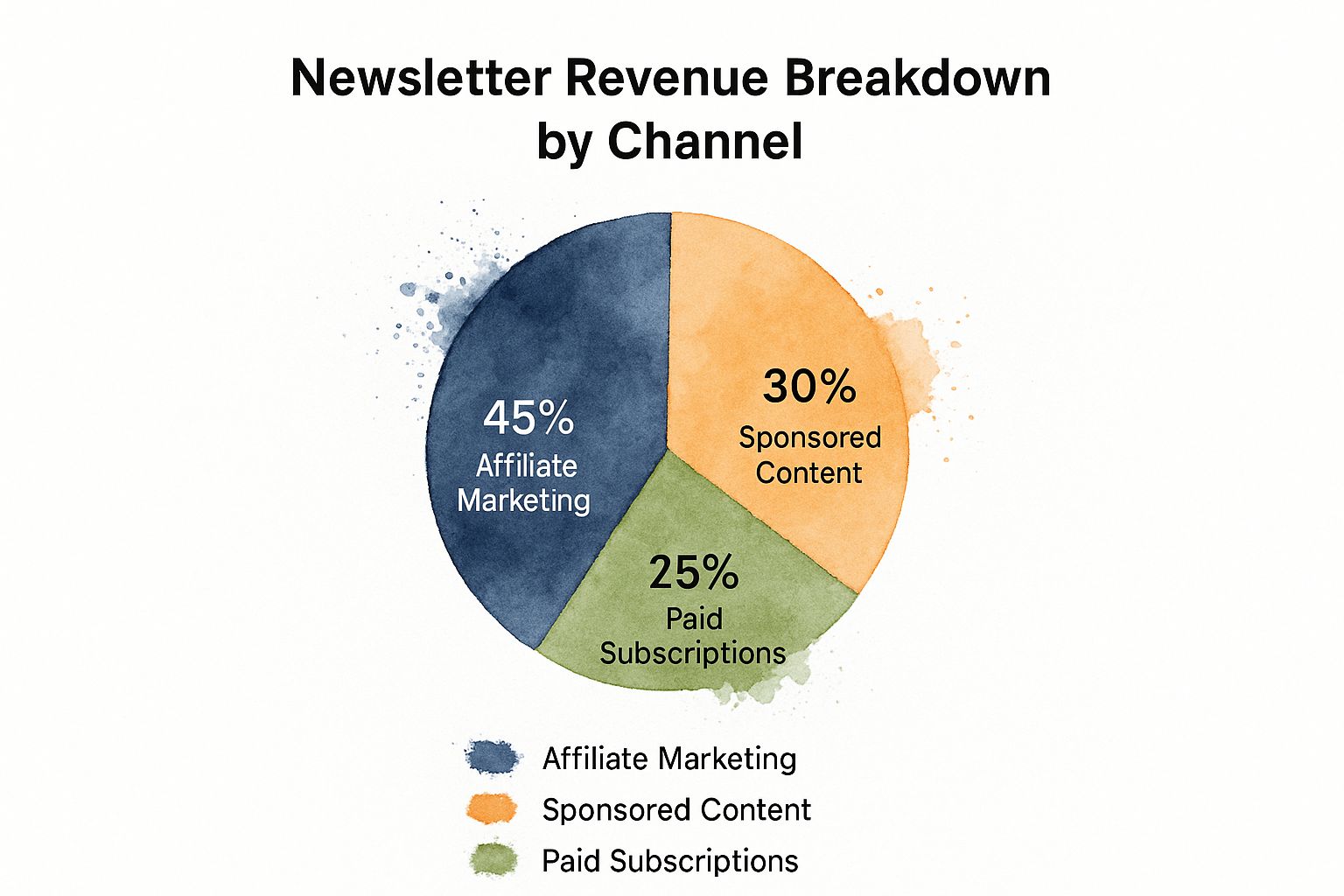- Grow Newsie
- Posts
- How To Make Money With A Newsletter: Your Complete Guide
How To Make Money With A Newsletter: Your Complete Guide
Discover how to make money with a newsletter through proven strategies. Learn subscription models, sponsorships, and advanced monetization tips.

The email newsletter landscape has changed. Newsletters have grown from simple updates into a powerful way to earn money. This change is happening because of how we now get information and interact with brands. Understanding newsletter monetization is a vital skill for content creators.
The Power of Direct Connection
Email newsletters are effective because they connect directly with an audience. Unlike algorithms on social media platforms like Facebook, email lets you talk directly to subscribers. This builds a sense of community and trust. This close connection creates higher engagement and conversion rates. A loyal subscriber is more likely to buy a product from a newsletter than a random social media user. This direct connection is at the heart of successful newsletter monetization.
Growth and The Global Audience
The potential reach of a newsletter is huge. The email newsletter industry remains a major channel for businesses and creators. This is thanks to a steadily growing audience. A 2024 Statista report projects 4.6 billion global email users by 2025. This is a big jump of about 600 million users. This massive user base gives newsletter owners a chance to connect with a global audience. This growth shows the enduring power of email. Learn more about newsletter statistics here: https://whop.com/blog/newsletter-statistics/
Newsletters come in different forms, each with different ways to earn money. Some newsletters offer exclusive content. Others collect information from different places. Some newsletters focus on building a community. This creates a loyal audience open to offers. Knowing these different types of newsletters is key to making money with them.
Realistic Expectations and Timelines
Earning money through a newsletter is possible. But it's important to have realistic goals. Building a profitable newsletter takes time and work. Success takes consistent content, audience engagement, and a strong plan to make money. We’ll look at practical strategies and tactics. These will help you reach your newsletter monetization goals.
Thinking of starting a newsletter?
I’ve partnered with the beehiiv team to set you up with:
✅ 20% off your first 3 months
✅ A free 30-day trial, no credit card needed
It’s packed with features that make creating great content easier: AI tools that save time, landing pages that convert better, and a built-in ad network to help you earn more.

Before monetizing your newsletter, you need a solid base. This means attracting and retaining the right subscribers. It's like building a house: a strong foundation is essential before adding the roof. This section covers the key elements of a profitable newsletter, from niche selection to using the right tools.
Niche Selection and Audience Research
A clearly defined niche is critical for newsletter success. This lets you target a specific audience with relevant content. Don't try to be everything to everyone. Focus on a specific area where you can offer unique value.
For example, instead of a general "business" newsletter, consider "sustainable practices for small restaurants." This targeted approach attracts a loyal audience interested in that specific information.
Understanding your target subscriber is key. What are their needs and pain points? What content do they value? This information shapes your content strategy and helps you create a newsletter people want. This is crucial for long-term growth and monetization.
Compelling Value Proposition and Engaging Content
Your value proposition sets your newsletter apart. It's the promise of benefits subscribers receive. This could be exclusive insights, practical tips, early access to information, or a sense of community. A strong value proposition attracts and retains subscribers.
Engaging content keeps subscribers interested. Consider different formats like curated links, original articles, interviews, or behind-the-scenes content. Experiment to find what resonates with your audience. Consistency matters, too. A regular publishing schedule keeps subscribers engaged. Check out this guide on How to master newsletter subscriber growth.
Technical Infrastructure and Subscriber Management
Choosing the right newsletter platform is crucial for managing subscribers and sending emails. Consider features like automation, analytics, and subscriber segmentation. A good platform facilitates scaling as your newsletter grows. This is a crucial aspect of a sustainable newsletter business.
Effective subscriber management is vital for organizing and communicating with your audience. Segment subscribers based on interests or engagement. This personalized approach allows you to tailor content and offers, leading to higher engagement and better monetization. You'll be sending the right message, to the right people, at the right time.
Use analytics to track your newsletter's performance. This data reveals what's working and what needs improvement. Tracking metrics like open rates, click-through rates, and unsubscribe rates offers valuable insights into subscriber behavior, helping you optimize content and grow your audience.
Mastering Subscription Revenue Models That Work

This pie chart shows how newsletter revenue typically breaks down across different channels. These include affiliate marketing, sponsored content, and paid subscriptions. Paid subscriptions make up 25% of potential revenue. This is a significant income stream if you use the right strategy.
Affiliate marketing (45%) and sponsored content (30%) are also valuable. But subscriptions offer a predictable, recurring income. Mastering subscription models is key to making money with your newsletter.
The Psychology of Pricing: Understanding Subscriber Value
Setting the right price is critical. You need to understand the perceived value of your content. A newsletter with exclusive stock tips, for example, can charge more than one with general market commentary. This is because subscribers see a chance for direct financial gain.
Focus on the tangible benefits you offer. What direct value does your content bring to your subscribers? Highlighting these benefits justifies your pricing and attracts the right audience.
A popular strategy is the freemium model. This means offering some valuable content for free, while keeping premium features behind a paywall. This lets potential subscribers try your newsletter before paying.
It also creates a clear upgrade path. Free subscribers see the extra value they could get, which encourages them to subscribe. This model balances accessibility with revenue generation.
Onboarding and Retention: Reducing Churn
Effective onboarding is vital for keeping subscribers. A good welcome sequence explaining the benefits of a paid subscription helps reduce churn. Consistently high-quality content also reinforces your value.
For more on monetization strategies, check out this guide: How to master content monetization strategies. Providing upfront value and ongoing engagement builds loyalty and increases revenue.
To help you understand the different pricing models available, we've compiled the following comparison:
Newsletter Subscription Pricing Models Comparison: A detailed comparison of different subscription pricing strategies and their effectiveness across various newsletter types.
Pricing Model | Average Monthly Price | Best For | Pros | Cons |
|---|---|---|---|---|
Freemium | Free (core content), $5-$20 (premium) | Building a large audience and then converting a portion to paid | Large audience potential, allows users to sample content | Requires significant free content creation, conversion rates can be low |
Tiered | $5-$50+ (depending on tiers) | Offering varying levels of access and content | Caters to different budgets and needs, potential for higher overall revenue | Can be complex to manage, requires clear value differentiation between tiers |
Flat Fee | $5-$20 | Niche newsletters with highly specialized content | Simplicity for both publisher and subscriber | May limit audience growth if price is too high |
This table outlines a few popular pricing structures for newsletters. Each model offers its own advantages and drawbacks. Choosing the right one depends on your content, audience, and business goals.
Testing and Optimization: Finding the Sweet Spot
Experiment with different price points. A/B testing various structures helps you find the sweet spot between attracting subscribers and making money. You might also find this interesting: How to master pricing different subscription types.
Getting feedback from your subscribers through surveys or polls can also be valuable. Using this data lets you refine your strategy and maximize your earnings over time.
Unlocking Sponsorship and Advertising Revenue

Once your newsletter has a substantial subscriber base, sponsorships and advertising can become viable revenue streams. However, a strategic approach is essential for maximizing earnings while keeping your subscribers happy. This section explores how to attract relevant sponsors, set fair rates, and implement effective advertising formats within your newsletter.
Attracting Quality Sponsors
Attracting the right sponsors is key. Your audience should be a good fit for the sponsor's products or services. For example, a newsletter about vegan cooking would likely attract sponsors offering plant-based meal kits or kitchen appliances. This targeted approach ensures relevance and boosts the chances of conversions.
Identify brands that align with your newsletter's niche and values. Reach out to them directly or consider using advertising networks. Make it easy for potential sponsors to find you by clearly outlining sponsorship opportunities on your website.
Setting Fair Rates and Negotiating Effectively
Setting sponsorship rates requires careful thought. Factors like audience size, engagement rates (opens and clicks), and audience demographics all play a role in your pricing. A highly engaged audience of 10,000 subscribers can often command higher rates than a larger, less engaged audience.
Be prepared to negotiate and be confident in the value you provide. Understanding your audience's purchasing power will strengthen your negotiating position. For more insights into typical newsletter ad rates, check out this helpful resource: How to master newsletter ad rates.
Different Advertising Formats and Media Kits
Various advertising formats can be incorporated into newsletters. Dedicated sponsor segments offer a prominent space for sponsors to showcase their offerings. Subtle mentions within the editorial content provide a more integrated approach. Experiment to find what works best for your audience and sponsors.
A well-crafted media kit is essential. It provides potential sponsors with crucial information about your newsletter, including audience demographics, engagement metrics, and advertising options. Include testimonials from past sponsors to build credibility.
Building Long-Term Brand Partnerships and Balancing Content
Think long-term. Cultivating lasting brand partnerships creates more stable revenue streams. By working with sponsors over extended periods, you build stronger relationships and gain a deeper understanding of their marketing objectives.
Maintaining a balance between promotional and editorial content is vital. While sponsorships generate revenue, your primary value lies in delivering valuable content. Too much promotion can lead to unsubscribes and damage your credibility. Clearly distinguish sponsored content from editorial content to maintain transparency and trust. This balance ensures your newsletter remains a valuable resource for your subscribers, fostering a loyal and engaged audience. By prioritizing audience needs, you build a strong foundation for long-term monetization success through sponsorships and advertising.
Diversifying Through Affiliate Marketing and Product Sales
Smart newsletter creators know that having multiple income streams is essential. Relying on just one can be risky. This section explores two great ways to boost your newsletter revenue: affiliate marketing and product sales. Used effectively, these strategies can significantly increase your earnings.
Integrating Affiliate Marketing Naturally
Affiliate marketing means promoting other companies' products or services in your newsletter. You earn a commission for each sale made through your unique affiliate link. The trick is to make these promotions fit seamlessly into your content. They should feel like authentic recommendations, not pushy ads.
For example, if your newsletter is about personal finance, you could partner with budgeting apps like YNAB or investment platforms like Fidelity. When you're discussing saving strategies, you could include an affiliate link to a budgeting tool you actually recommend. This adds value for your readers while potentially bringing in extra income for you.
Choose relevant programs: Pick affiliate programs that match your niche and what your audience is interested in. This makes your recommendations relevant and increases the chance of conversions.
Disclose your affiliations: Being transparent is vital. Always tell your subscribers about your affiliate relationships to keep their trust.
Prioritize value: Focus on recommending products you truly believe in. Your credibility is key.
Creating and Selling Your Own Digital Products
Besides affiliate marketing, your newsletter is a great place to sell your own digital products. These could be ebooks, online courses, templates, or exclusive content. Consider the value you offer your readers. What special knowledge can you turn into a product?
This moves you from content creator to entrepreneur. Using the trust and connection you’ve built with your subscribers can generate substantial income.
Ebooks and Guides: Gather your best tips and insights into a downloadable ebook.
Online Courses: Turn your expertise into structured lessons.
Templates and Tools: Offer helpful resources that enable your subscribers to reach their goals.
Exclusive Content: Offer premium content, like detailed reports or early access to info, behind a paywall.
Launching Your Products and Cross-Selling
Announce and promote your product launches through your newsletter. Generate excitement before the launch to maximize sales. Offer exclusive discounts or early bird pricing to your loyal subscribers. Once you have a few products, cross-selling is a natural next step. For instance, if you have a course on writing newsletters, you could cross-sell an ebook on monetization strategies. Related products offer more value and increase your income potential.
Building Credibility and Driving Consistent Sales
Your newsletter’s credibility is your greatest strength. Subscribers who appreciate your content are more inclined to buy your products. Focus on building trust by consistently delivering high-quality content and honest recommendations. This helps you smoothly transition from giving value to making sales. By understanding and nurturing your audience, you can use your newsletter to create a reliable stream of income from your digital products.
Advanced Monetization and Scaling Strategies
Building a profitable newsletter takes time and effort. Once you’ve established your subscriber base and explored fundamental monetization strategies like subscriptions, ads, and affiliate marketing, you can explore advanced techniques to boost your revenue. Think of it as taking your newsletter to the next level.
One way to expand your reach is by joining a premium newsletter network. These networks often have established relationships with brands, providing access to wider audiences and potential sponsorship opportunities. It’s like joining a professional organization – you gain access to resources and connections you wouldn’t have otherwise.
Content licensing offers another revenue avenue. Repurposing your top-performing newsletter content into different formats, like ebooks or online courses, or even licensing it to other publications, can create new income streams. This maximizes the value of the content you've already created.
Paid Events, Webinars, and Exclusive Communities
Hosting paid events and webinars allows you to connect with your subscribers in a more interactive way. Offering exclusive insights, Q&A sessions, and networking opportunities adds value and justifies a premium price for attendees. These events provide a personal touch and strengthen your community.
Creating exclusive communities for paid subscribers offers a sense of belonging and provides access to premium content. A private forum, Slack group, or Discord server can be a great way for subscribers to interact with you and each other. This fosters loyalty and provides ongoing value beyond the newsletter itself.
Automating Revenue Streams and Implementing Dynamic Pricing
Automating your revenue streams is key to scaling. Setting up recurring billing for subscriptions and automating affiliate marketing campaigns streamlines your operations. Think of it as building a system that works efficiently without constant manual input.
Dynamic pricing offers flexibility by allowing you to adjust pricing based on factors like demand and subscriber engagement. This might involve limited-time discounts or premium pricing for high-value content, ultimately maximizing your revenue over time.
Data Analytics and Strategic Partnerships
Using data analytics to track metrics like open rates, click-through rates, and conversion rates provides insights into what resonates with your audience. Data-driven decisions help you refine your strategies and improve your results. Tools like Google Analytics can be invaluable for tracking these metrics.
Strategic partnerships with other businesses or creators can significantly broaden your reach. Cross-promotion exposes your newsletter to new audiences, benefiting both partners. It's a mutually beneficial way to increase visibility and expand your subscriber base.
Preparing for Acquisition or Investment
While not the immediate goal, preparing your newsletter for potential acquisition or investment is a strategic move. Maintaining organized financial records, documenting your processes, and building a strong brand identity can make your newsletter more attractive to potential buyers or investors in the future. This preparation positions you for potential growth opportunities down the line.
To understand how different monetization strategies compare, take a look at the table below:
Newsletter Revenue Stream Performance Metrics
Key performance indicators and benchmarks for different newsletter monetization methods
Revenue Stream | Average Revenue Per Subscriber | Time to Profitability | Difficulty Level | Scalability |
|---|---|---|---|---|
Advertising | $0.10 - $0.50 | Relatively Quick | Easy | Moderate |
Subscriptions | $5 - $50+ | Moderate | Medium | High |
Affiliate Marketing | $1 - $10+ | Varies | Medium | Moderate |
Sponsorships | $500 - $5,000+ per campaign | Moderate to Long | Hard | Moderate |
Paid Events/Webinars | $50 - $500+ per event | Moderate | Medium | Moderate |
Content Licensing | Varies widely | Long | Hard | High |
Exclusive Communities | $10 - $100+ per month | Moderate | Medium | High |
This table summarizes the potential revenue, time to profitability, difficulty, and scalability of common newsletter monetization methods. As you can see, each method has its own pros and cons, and the best approach will depend on your specific niche, audience, and goals. By implementing these advanced strategies, you can transform your newsletter from a simple communication tool into a thriving and profitable business.
Key Takeaways
Building a profitable newsletter requires dedication and a well-defined strategy. This section offers a roadmap to help you navigate the world of newsletter monetization. We'll summarize key strategies and highlight the metrics that truly matter for success. Think of it as your cheat sheet for building a thriving newsletter empire.
Building a Strong Foundation
Before you even consider monetization, you need a solid foundation. Start by choosing a specific niche and understanding your target audience. What problems are they facing? How can your newsletter provide solutions? A well-defined niche attracts a loyal audience, which is the cornerstone of any profitable newsletter.
Your value proposition is crucial. This is the unique benefit you offer your readers. It could be exclusive content, expert insights, or a strong sense of community. A compelling value proposition draws subscribers in and keeps them engaged. Consistently delivering valuable content in various formats reinforces this value.
Finally, the right technical infrastructure is essential. Select a newsletter platform like Mailchimp that can scale with your growth. Look for features like subscriber management and analytics. These tools allow for personalized communication and data-driven optimization, both of which are essential for long-term success.
Monetization Strategies: Diversify Your Income
Newsletters offer a variety of monetization options. Paid subscriptions provide predictable, recurring income. This can be achieved through a freemium model or tiered offerings. Understanding pricing psychology is key to setting rates subscribers find reasonable. Ask yourself: what value does your content truly offer?
Sponsorships and advertising can be lucrative. Partner with brands that align with your niche and values. Maintain a balance between promotional and editorial content to preserve subscriber trust.
Affiliate marketing is another income stream. Recommend relevant products or services and earn a commission on sales. Prioritize genuine recommendations and always disclose affiliate relationships to maintain credibility.
Creating and selling your own digital products through your newsletter transforms you from content creator to entrepreneur. This allows you to capitalize on your expertise and audience trust.
Scaling and Advanced Strategies
Advanced strategies can take your newsletter to the next level. Joining premium newsletter networks expands your reach, while content licensing repurposes existing content for additional revenue streams.
Hosting paid events like webinars offers interactive engagement opportunities. Building exclusive communities creates a deeper sense of belonging for subscribers.
Automation and data are valuable tools. Automate revenue streams, implement dynamic pricing, and use data analytics to optimize your efforts. Strategic partnerships with other creators through cross-promotion expose your newsletter to new audiences. Consider the potential for acquisition, positioning your newsletter as a valuable asset and a potential exit strategy.
Measuring Success: Key Metrics and Benchmarks
Tracking key performance indicators (KPIs) is vital for evaluating success. Monitor open rates, click-through rates, and conversion rates for each monetization strategy. For instance, if your newsletter has 10,000 subscribers and 20% subscribe to a $10/month premium tier, that's $2,000/month in revenue.
Increasing subscriber engagement through high-quality content and targeted segmentation improves these metrics, ultimately boosting your revenue. Building a profitable newsletter takes time. Focus on delivering value, refining your strategies, and adapting based on data and feedback. Success is built on consistent effort and a clear understanding of your audience and niche.
